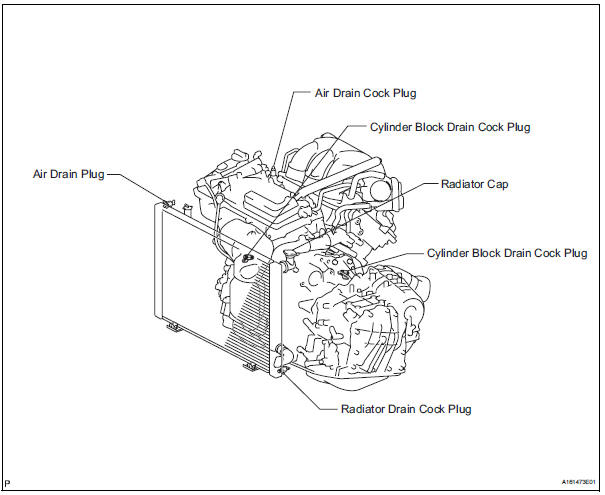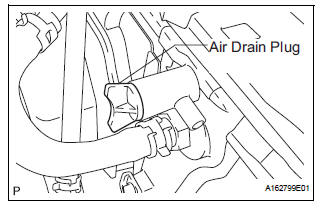Toyota Sienna Service Manual: Coolant
Replacement
1. REMOVE NO. 1 ENGINE UNDER COVER (See page EM-26) 2. REMOVE V-BANK COVER SUB-ASSEMBLY (See page EM-28) 3. DRAIN ENGINE COOLANT
(a) Loosen the radiator drain cock plug.

HINT: Collect the coolant in a container and dispose of it according to the regulations in your area.
(b) Remove the radiator cap sub-assembly from the radiator assembly.
| NOTICE:
Do not remove the radiator cap sub-assembly
while the engine and radiator are still hot.
Pressurized, hot engine coolant and steam may be released and cause serious burns. |
(c) Loosen the 2 cylinder block drain cock plugs.
4. ADD ENGINE COOLANT

(a) Tighten the radiator drain cock plug by hand.
(b) Tighten the 2 cylinder block drain cock plugs.
Torque: 13 N*m (130 kgf*cm, 9 ft.*lbf) for cylinder block drain cock plugs (c) Remove the air drain cock plug from the water inlet housing.
(d) Loosen the air drain plug at the top of the radiator 3 or 4 turns.
(e) Add TOYOTA Super Long Life Coolant (SLLC) to the radiator inlet opening until coolant overflows from the engine air drain cock hole. Then install the air drain cock plug to the water inlet housing.
Torque: 13 N*m (130 kgf*cm, 9 ft.*lbf) for air drain cock plug (f) Continue to add TOYOTA Super Long Life Coolant (SLLC) to the radiator inlet opening until coolant overflows from the radiator air drain hole. Then close the air drain plug at the top of the radiator.
HINT: If the coolant level at the radiator inlet opening drops after squeezing the No. 1 and No. 2 radiator hoses, add coolant.
(g) Slowly fill the radiator with TOYOTA Super Long Life Coolant (SLLC).
Standard capacity: 11.3 liters (12.0 US qts, 10.0 Imp. qts)
HINT:
- TOYOTA vehicles are filled with TOYOTA SLLC at the factory. In order to avoid damage to the engine cooling system and other technical problems, only use TOYOTA SLLC or similar high quality ethylene glycol based non-silicate, non-amine, non-nitrite, non-borate coolant with long-life hybrid organic acid technology (coolant with long-life hybrid organic acid technology consists of a combination of low phosphates and organic acids).
- Contact your TOYOTA dealer for further details.
| NOTICE: Never use water as a substitute for engine coolant. |
(h) Slowly pour coolant into the radiator reservoir tank until it reaches the FULL line.
(i) Squeeze the No. 1 and No. 2 radiator hoses several times by hand, and then check the level of the coolant.
If the coolant level is low, add coolant.
(j) Bleed air from the cooling system.
(1) Warm up the engine until the thermostat opens.
While the thermostat is open, circulate the coolant for several minutes.
HINT: The thermostat open timing can be confirmed by squeezing the inlet radiator hose by hand, and checking when the engine coolant starts to flow inside the hose.
(2) Maintain the engine speed at 2500 to 3000 rpm.
(3) Squeeze the inlet and outlet radiator hoses several times by hand to bleed air.
| CAUTION: When squeezing the radiator hoses:
|
NOTICE:
|
(k) Stop the engine and wait until the engine coolant cools down.
(l) Add engine coolant to the FULL line on the radiator reservoir.
5. INSPECT FOR COOLANT LEAK (See page CO-1) 6. INSTALL V-BANK COVER SUB-ASSEMBLY (See page EM-63) 7. INSTALL NO. 1 ENGINE UNDER COVER (See page EM-63)
 On-vehicle inspection
On-vehicle inspection
1. INSPECT COOLING FAN SYSTEM
(a) Put the vehicle in the following conditions
(1) The engine switch is off.
(2) The coolant temperature is less than 95°C
(203°F).
(3) The battery voltage is ...
 Water pump
Water pump
COMPONENTS
...
Other materials:
Open in Side Squib RH Circuit
DTC B0111/44 Open in Side Squib RH Circuit
DESCRIPTION
The side squib RH circuit consists of the center airbag sensor assembly and
the front seat side airbag
assembly RH.
The circuit instructs the SRS to deploy when deployment conditions are met.
DTC B0111/44 is recorded when an open circ ...
Installation
1. INSTALL REAR DRIVE SHAFT ASSEMBLY LH
(a) Install the drive shaft to the axle carrier.
NOTICE:
Be careful not to damage the boot and ABS
speed sensor rotor to the drive shaft and oil seal
of the axle hub bearing.
(b) Align the matchmarks and connect the drive shaft to
the side gear shaf ...
Dinghy towing
Your vehicle is not designed to be dinghy towed (with 4 wheels
on the ground) behind a motor home.
NOTICETo avoid serious damage to your vehicle
Do not tow your vehicle with four wheels
on the ground.
To prevent causing serious damage to the transaxle and Active
Torque ...
